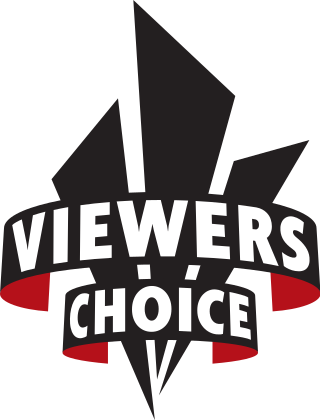
The Canadian Radio-television and Telecommunications Commission is a public organization in Canada with mandate as a regulatory agency for broadcasting and telecommunications. It was created in 1976 when it took over responsibility for regulating telecommunication carriers. Prior to 1976, it was known as the Canadian Radio and Television Commission, which was established in 1968 by the Parliament of Canada to replace the Board of Broadcast Governors. Its headquarters is located in the Central Building of Les Terrasses de la Chaudière in Gatineau, Quebec.

4DTV is a proprietary broadcasting standard and technology for digital cable broadcasting and C-band/Ku-band satellite dishes from Motorola, using General Instrument's DigiCipher II for encryption. It can tune in both analog VideoCipher 2 and digital DCII satellite channels.
CHBX-TV is a television station in Sault Ste. Marie, Ontario, Canada, part of the CTV Television Network. It is owned and operated by network parent Bell Media, and maintains studios and transmitter facilities on 6 Line East in Sault Ste. Marie.
Pay television, also known as subscription television, premium television or, when referring to an individual service, a premium channel, refers to subscription-based television services, usually provided by multichannel television providers, but also increasingly via digital terrestrial, and streaming television. In the United States, subscription television began in the late 1970s and early 1980s in the form of encrypted analog over-the-air broadcast television which could be decrypted with special equipment. The concept rapidly expanded through the multi-channel transition and into the post-network era. Other parts of the world beyond the United States, such as France and Latin America have also offered encrypted analog terrestrial signals available for subscription.

Bell Satellite TV is the division of BCE Inc. that provides satellite television service across Canada. It launched on September 10, 1997. As of April 2017, Bell Satellite TV provides over 700 channels to over 1 million subscribers. Its major competitors include satellite service Shaw Direct, as well as various cable and communications companies across Canada.
In cable television, governments apply a must-carry regulation stating that locally licensed television stations must be carried on a cable provider's system.
Superstation is a term in North American broadcasting that has several meanings. Commonly, a "superstation" is a form of distant signal, a broadcast television signal—usually a commercially licensed station—that is retransmitted via communications satellite or microwave relay to multichannel television providers over a broad area beyond its primary terrestrial signal range.
Avis de Recherche (AdR) is a Canadian French language Category B specialty channel devoted to crime prevention. Despite AdR's Category B licence, it was formerly a must-carry channel in the province of Quebec on digital basic cable.
Canada is served by various multichannel television services, including cable television systems, two direct-broadcast satellite providers, and various other wireline IPTV and wireless MMDS video providers.

Viewers Choice was a Canadian English language pay-per-view (PPV) and near video on demand service. It was owned by Viewers Choice Canada Inc., which at the time of its closure was majority-owned and managed by Bell Media, with minority partners Rogers Media and ESPN Inc., and had been carried by various cable and IPTV service providers, primarily in Eastern Canada.
Multichannel television in the United States has been available since at least 1948. The United States is served by multichannel television through cable television systems, direct-broadcast satellite providers, and various other wireline video providers; among the largest television providers in the U.S. are DirecTV, Altice USA, Charter Communications, Comcast, Dish Network, and Verizon Communications. The Telecommunications Act of 1996 defines a multichannel video programming distributor (MVPD) as "a person such as, but not limited to, a cable operator, a multichannel multipoint distribution service, a direct broadcast satellite service, or a television receive-only satellite program distributor, who makes available for purchase, by subscribers or customers, multiple channels of video programming", where a channel is defined as a "signaling path provided by a cable television system."
A la carte pay television, also referred to as pick-and-pay, is a pricing model for pay television services in which customers subscribe to individual television channels. For subscription distribution services, a la carte pricing contrasts with the prevailing model of bundling, in which channels are grouped into packages that are offered on an all-or-nothing basis.
G-Sat is a subscription-based direct-to-home (DTH) satellite television service commercially available in the Philippines. G-Sat is owned by Global Satellite Technology Services (GSTS), registered in the Philippines with the Securities and Exchange Commission (SEC). G-Sat also carried pay TV channels from Hong Kong, Macau and Taiwan, which TV shows and movies subtitled in Cantonese and Mandarin.
Fee-for-carriage, value-for-signal, negotiation for value, or the "TV tax" all refer to a proposed Canadian television regulatory policy which would require cable and satellite television companies to compensate conventional, over-the-air television stations for the right to carry their local signals. Such a system has long existed in the United States, under the name of retransmission consent.
Satellite television varies in the different regions around the world.
Direct-to-Home (DTH) television is a method of receiving satellite television by means of signals transmitted from direct-broadcast satellites. The Government of India (GoI) permitted the reception and distribution of satellite television signals in November 2000. The first DTH service in the country was launched by Dish TV on 2 October 2003. DD Free Dish, the first free DTH service in India, was launched by public broadcaster Prasar Bharati in December 2004.
A carriage dispute is a disagreement over the right to "carry", that is, retransmit, a broadcaster's signal. Carriage disputes first occurred between broadcasters and cable companies and now include direct broadcast satellite and other multichannel video programming distributors.

WWE Network is a Canadian English language specialty channel programmed by WWE and distributed by Rogers Sports & Media. Its programming consists entirely of the linear feed offered as part of the WWE Network video streaming service.
Shomi was a Canadian subscription video on demand service jointly owned by Rogers Communications and Shaw Communications, in operation from 2014 to 2016. The service was viewed as a Canadian-based competitor to Netflix, with a library of 1,200 films and 11,000 hours' worth of television programs available on launch. Shomi content could be accessed as an over-the-top service through the service's website and apps, or through the video-on-demand libraries of participating television providers. The service emphasized manually curated categories of content, in contrast to the algorithmic approach used by competing services.
A 9(1)(h) order is an order issued by the Canadian Radio-television and Telecommunications Commission (CRTC) pursuant to section 9(1)(h) of Canada's Broadcasting Act. It requires that a particular Canadian television channel be distributed by all (or a particular subset of) cable, satellite, IPTV, or similar subscription-based television service providers in Canada. In most (but not all) cases, the order requires that the channel be included in the analogue and/or digital basic service, making it available to all subscribers of that TV service provider. A channel subject to such an order, particularly those subject to mandatory carriage on the basic service, is sometimes known as an 9(1)(h) service.
2. CRTC Broadcasting Public Notice 2005-35
3. CRTC Broadcasting Public Notice 2005-41
4. CRTC Broadcasting Public Notice 2006-133
5. CRTC Broadcasting Public Notice 2006-134
6. CRTC Broadcasting Public Notice 2006-135
7. Letter from Bell ExpressVu to CRTC dated April 18, 2006
8. Letter from StarChoice to CRTC dated April 18, 2006
12. Bell ExpressVu User Agreement – Residential July 2005
13. Bell ExpressVu User Agreement – Commercial September 30, 2005




